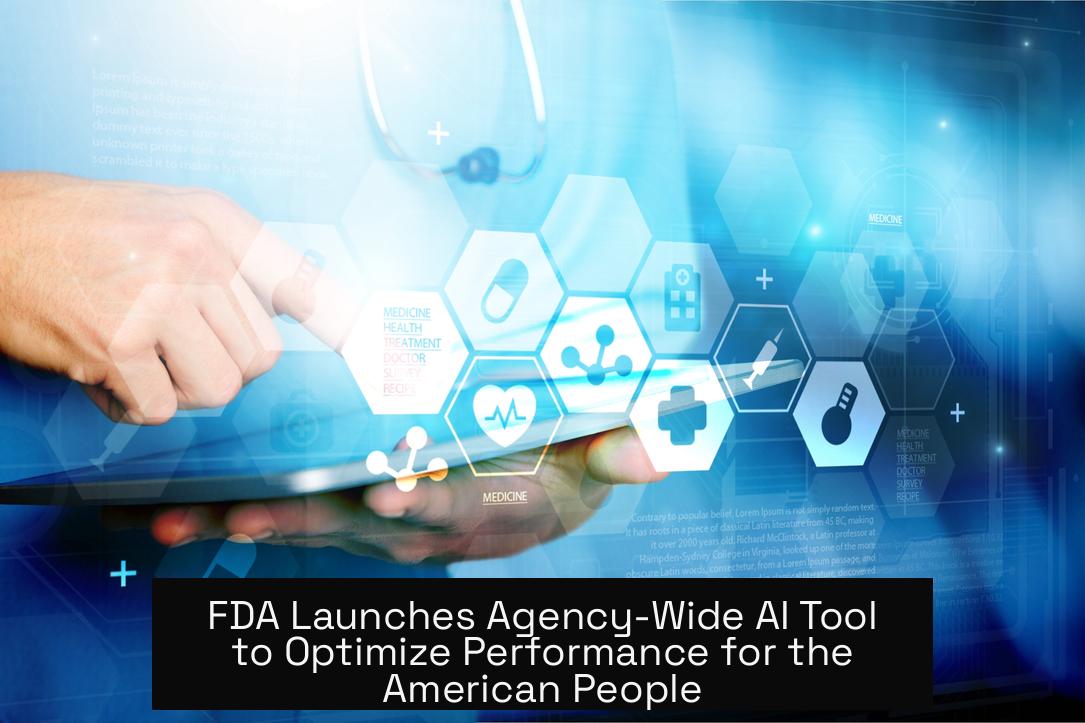Table of Contents
ToggleFDA Launches Agency-Wide AI Tool to Optimize Performance for the American People

The U.S. Food and Drug Administration (FDA) launches Elsa, an innovative generative AI tool, agency-wide to enhance employee efficiency and optimize operations for the American public. This technology supports roles ranging from scientific reviewers to investigators, aiming to modernize FDA functions and improve service delivery.
Introduction of Elsa and Rollout Strategy
Elsa emerged from a successful pilot with FDA’s scientific reviewers. Due to promising results, FDA Commissioner Marty Makary accelerates its expansion to all FDA centers ahead of the targeted June 30 deadline. The rollout stays under budget via coordinated efforts among internal experts.
Security and Data Privacy Measures
- Elsa operates in a secure GovCloud environment, ensuring robust data protection.
- The AI models do not train on industry-submitted data, safeguarding confidential research.
- All information accessed remains within FDA’s secured infrastructure to maintain integrity.
Impact and Functionalities of Elsa
FDA Chief AI Officer Jeremy Walsh describes Elsa as a transformative AI tool that enhances employee productivity and agency potential. The AI aids in clinical protocol reviews, speeds up scientific evaluations, and helps target inspections effectively.
| Function | Description |
|---|---|
| Adverse Event Summarization | Facilitates safety profile assessments by summarizing adverse events rapidly. |
| Label Comparisons | Enables faster comparison of medical labels for accuracy and consistency. |
| Code Generation | Supports development of databases for nonclinical applications through automated code creation. |
Future Directions for AI at FDA
The launch of Elsa is a foundational step. The FDA plans to extend AI integration across data processing and other generative AI functions. This strategy is designed to deepen AI’s impact on regulatory processes and support the agency’s public health mission.
Collaborative Implementation
Elsa’s deployment showcases FDA’s capability to innovate responsibly. Agency-wide collaboration between leaders and technical teams ensures efficiency and alignment with FDA priorities.
Key Takeaways
- Elsa is a generative AI tool deployed agency-wide to boost FDA employee performance.
- It enhances clinical review speed, scientific evaluation, and inspection targeting.
- Built within a secure GovCloud, Elsa protects sensitive FDA data and does not train on regulated industry submissions.
- The AI tool supports adverse event summaries, label comparisons, and code generation.
- FDA plans expanded AI use to improve data processing and workflow automation.
- Agency-wide collaboration enabled early, under-budget rollout ahead of schedule.
FDA Launches Agency-Wide AI Tool to Optimize Performance for the American People
What exactly is the FDA’s new AI tool Elsa, and how will it optimize performance for the American people? Simply put, Elsa is a game-changing generative AI designed to help FDA employees across departments work faster and smarter, advancing public health protections with greater efficiency.
Yes, you heard that right. The U.S. Food and Drug Administration, the guardian of our food, drugs, and medical devices, just rolled out Elsa—an AI assistant that’s set to revolutionize how the agency operates behind the scenes. Ready to dive into the hows and whys of this innovation? Let’s unpack the story.
The Birth of Elsa: A Tailored AI for the FDA Workforce
FDA isn’t talking about some off-the-shelf chatbot here. Elsa is a large language model-powered tool created to help a diverse set of users—from scientific reviewers neck-deep in data to site investigators packing complex reports. Elsa does the heavy lifting of synthesizing information, writing summaries, and handling routine data tasks.
For example, Elsa accelerates clinical protocol reviews by quickly digesting extensive documentation and flagging key points. It shortens scientific evaluation timeframes and even helps identify which inspection targets are most urgent. This translates to faster FDA decisions, enhancing safety monitoring and regulatory actions for you, the public.
Ahead of Schedule, Under Budget: The Magic of Collaboration
The route to Elsa’s agency-wide rollout wasn’t just smooth—it was surprisingly swift. After a successful pilot program with scientific reviewers, FDA Commissioner Marty Makary pushed a bold deadline: make Elsa available agency-wide by June 30. Guess what? The team hit that target early, demonstrating the power of in-house teamwork and cutting-edge technology.
“Today’s rollout of Elsa is ahead of schedule and under budget, thanks to the collaboration of our in-house experts across the centers,” says Makary.
This is a prime example of an agency ditching silos and embracing cooperation. Leaders and tech gurus from every center joined forces to bring Elsa to life. The FDA is proving how a sustainable AI deployment can happen with thoughtful planning and cross-team collaboration.
Security Shouldn’t Be an Afterthought—Elsa is Built for Privacy
Introducing AI at a government agency sounds exciting, but raises natural questions about data privacy and security. The FDA tackles this head-on. Elsa operates entirely within a high-security GovCloud environment, keeping all sensitive materials behind FDA firewalls.
In other words, any data Elsa accesses stays within the agency’s fortress. The AI model doesn’t train on data from regulated industries either, protecting confidential research from outside influence. This safeguards the integrity of FDA’s work and maintains public trust.
Beyond Buzzwords: How Elsa Empowers FDA Employees Today
Elsa is more than just a shiny tech toy—it’s a dynamic, evolving tool. Jeremy Walsh, the FDA’s Chief AI Officer, describes Elsa as a “dynamic force enhancing and optimizing the performance and potential of every employee.” The AI tool streamlines reading and writing through summaries and information synthesis. For example:
- Elsa summarizes adverse event reports to improve safety profile assessments.
- It performs quick label comparisons, helping ensure accurate medication information.
- Generates code that supports database development for nonclinical studies.
Imagine the hours saved and the errors avoided when these tasks become automated. The FDA can redirect human expertise toward more complex, high-impact challenges.
Looking Ahead: The FDA’s Long Game with AI
Elsa represents only the beginning of AI integration at the FDA. Plans are already underway to weave AI deeper into data processing, regulatory reviews, and other generative AI functions. This gradual approach ensures the agency learns, adapts, and scales AI responsibly.
That’s important because rushing new tech into highly regulated fields without understanding consequences can lead to setbacks. By starting with Elsa and expanding thoughtfully, the FDA sets a high bar for how government agencies can leverage AI safely and effectively.
Why Should We Care About an AI for the FDA?
You might wonder, “Cool tech for government workers, but what does this mean for me?” The real impact comes in the form of faster drug approvals, improved medical safety checks, and more targeted inspections, which can save lives and prevent harm. When FDA works efficiently, the American public receives safer products sooner.
Plus, healthier communities lower overall healthcare costs and boost our economy. Elsa’s power to streamline workflows lets staff focus on high-priority, complex issues rather than drown in paperwork. It’s innovation serving the people, plain and simple.
Final Thoughts: Trusting Tech, But With Human Oversight
Elsa marks a new chapter for the FDA—a blend of high-tech AI muscle and skilled human judgment. This partnership promises faster, smarter regulatory work while maintaining rigorous safety standards.
Can we expect AI tools like Elsa to become the norm at other agencies? Probably. But FDA’s example shows how to do it right: incrementally, securely, and collaboratively.
Have you ever imagined an AI helping protect your health? Elsa is making that future a present reality. And if the FDA’s rollout is anything to go by, AI’s role in public service is just getting started.
What is Elsa and who can use it at the FDA?
Elsa is a generative AI tool designed to help FDA employees work more efficiently. It supports users from scientific reviewers to investigators in various agency tasks.
How does Elsa protect sensitive FDA data and maintain security?
Elsa operates within a secure GovCloud environment. It does not train on data from the regulated industry, ensuring confidential research remains protected inside the agency.
What specific functions does Elsa perform for FDA staff?
- Summarizes adverse events to aid safety assessments.
- Speeds up clinical protocol reviews and scientific evaluations.
- Generates code and compares drug labels quickly.
How was Elsa developed and implemented across the FDA?
The tool was piloted successfully with scientific reviewers. An all-center collaboration helped rollout the AI agency-wide ahead of schedule and under budget.
What future AI plans does the FDA have following Elsa’s launch?
The FDA aims to expand AI use in data processing and generative functions. Elsa is the first step toward integrating more AI tools to enhance agency operations.




